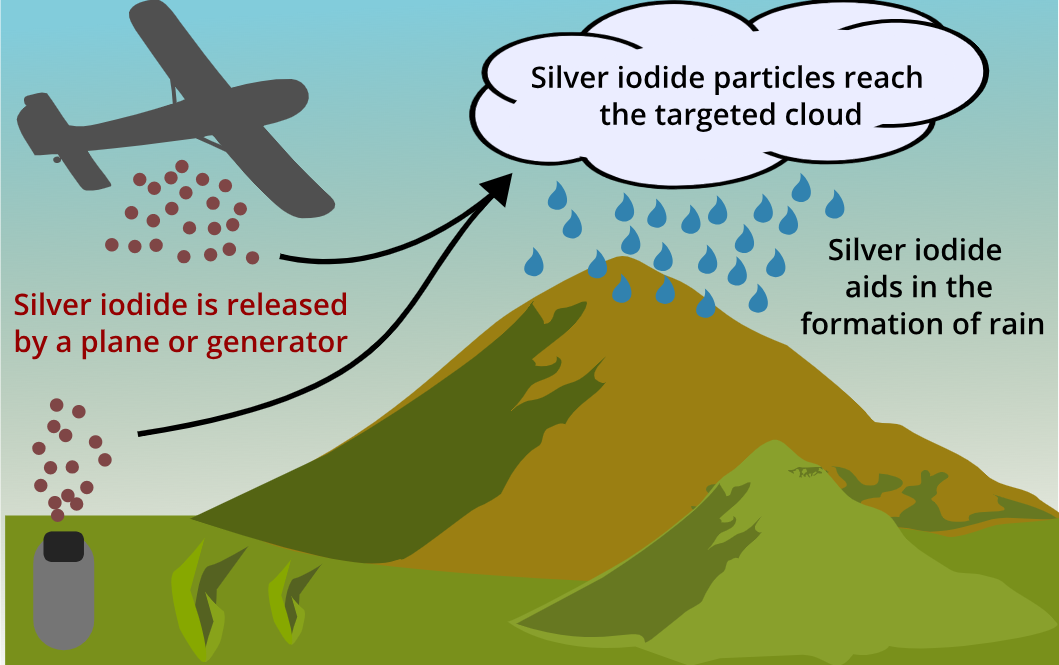Cloud Seeding: Cloud seeding is considered to be an artificial phenomenon wherein artificial precipitation is created by infusing some chemicals into the air which acts as cloud condensation nuclei. The cloud seeding has an advantage in pollution removal, as the artificial rain created by it removes the pollutants from the air. There are different types of cloud seeding available depending on the chemicals being used.
Recently, the cloud seeding technique has been used in Delhi to control the burgeoning air pollution which increased during the times of Diwali.
What is Cloud Seeding?
Cloud seeding is a technique in which certain substances (seeding agents) are introduced into existing clouds to enhance the formation of rain or snow. These substances act as condensation nuclei or ice nuclei, enabling water vapour or super-cooled droplets to coalesce and fall as precipitation. Importantly, cloud seeding cannot create clouds out of clear sky, it works only when suitable clouds already exist.

Cloud Seeding Process
Cloud seeding involves dispersing substances like silver iodide, potassium iodide, sodium chloride, or dry ice (solid CO₂) into clouds using aircraft. The step-by-step process is mentioned below:
-
Identification of suitable clouds: Clouds must be present, with sufficient moisture content and often vertical development.
-
Delivery of seeding agent: The seeding agents are sprayed into the clouds through a rocket or an aircraft.
-
Introduction of seeding material: The seeding agents such as silver iodide are introduced into the clouds which then act as condensation nuclei or ice nuclei and will help in artificial precipitation.
-
Precipitation formation and fall-out: Once the seeding agent amplifies droplet/ice formation, the enlarged droplets or crystals may fall as rain or melt and then fall as rain. In effect, the process enhances the cloud’s natural precipitation potential.
Cloud Seeding Chemicals
Cloud seeding process involves agents like silver iodide, potassium iodides, dry ice (solid carbon dioxide) or liquid propane. Check the types of agents and their characteristics below:
| Seeding Agent | Usage | Key Features |
| Silver iodide (AgI) | Used primarily for cold cloud seeding (ice-nucleation) | Crystalline structure similar to ice |
| Dry ice (solid CO₂) | Also for cold clouds, works by rapid cooling and creating ice crystals | Earlier method of seeding. |
| Sodium chloride (NaCl) or Potassium chloride (KCl) | Used in warm cloud seeding (droplet coalescence) | Hygroscopic salts that help droplets merge and grow. In the Indian context, warm cloud seeding uses salts. |
| Other hygroscopic materials (e.g., liquid propane vapour) | Emerging/alternative methods |
Advantages of Cloud Seeding
There are a number of advantages associated with cloud seeding. Cloud seeding helps in controlling air pollution, augmenting rainfall, etc.
-
Rainfall augmentation: The regions which are drought-prone and have water scarcity, cloud seeding can enhance precipitation, thereby increasing water availability for agriculture, reservoirs etc.
-
Air-pollution mitigation: The rain is helpful in washing out the pollutants from the air, which means that if there is no rain then there will be a lot of pollutants available. Therefore, cloud seeding helps in inducing rainfall which will ultimately help reduce the Particulate Matter (PM) from the environment.
-
Emergency relief mechanism: Cloud seeding can prove to be beneficial as a short-term measure in situations where emergency response is required. For example, if there is fog near the airport, then the cloud seeding mechanism can be used to disperse the fog, increasing the visibility in the area.
-
Supporting agriculture: Cloud seeding can help support agriculture by suppressing hailstorms or altering the weather conditions as per the requirement.
Cloud Seeding Challenges and Limitations
There are always some challenges and limitations associated with every innovation. The same applies to cloud seeding.
-
Favourable meteorological conditions: Clouds are the biggest requirement in the cloud seeding mechanism. As the months from October to December (post monsoon season), where monsoon clouds and low-pressure systems have already withdrawn, the cloud seeding becomes difficult.
-
Short-term impact: The weather conditions produced through cloud seeding mechanisms are short-lived and provide only temporary solutions.
-
Environmental concerns: The usage of silver iodide as a seeding agent is of concern as it accumulates into the soil. The prolonged effects still needs research.
Cloud Seeding Delhi
Delhi environment department and IIT-Kanpur has signed an MoU for the budget for cloud seeding. A total layout of 3.2 crores have been allocated to test the cloud seeding mechanism to curb the air pollution in Delhi. This budget is allocated for five cloud seeding trials.
Comments
All Comments (0)
Join the conversation